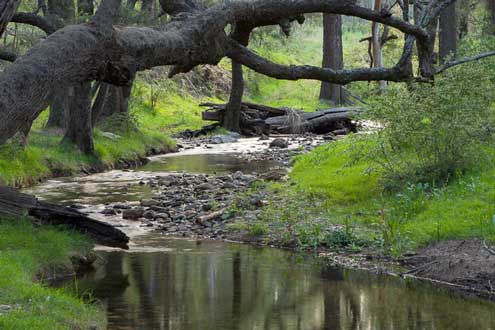Some areas of coastal floodplain forest remain at lower elevations in the east, where the fertile alluvial soils support small remnants of apple-gum woodlands.
Forested wetlands, also known as swamp sclerophyll forests, are freshwater wetlands dominated by trees.
They occur across just 0.5% of the Greater Blue Mountains on the fertile alluvial clays and sandy loams of the larger river valleys.
These habitats are structurally similar to other forests in that they are dominated by sclerophyllous trees; however, their understorey is distinctive, being comprised of plants that are able to survive periodic inundation.
Two classes of forested wetlands are found in the Greater Blue Mountains. Both occur as very narrow, linear strips along watercourses and their ecology is driven by flooding events.
Coastal Floodplain Wetlands
Coastal Floodplain Wetlands occur on rich, alluvial soils in the eastern parts of the Greater Blue Mountains, where creeks and rivers reach low lying terrain on the edge of the coastal plain.
Alluvial flats and elevated terraces along these creeks and rivers support forests of Rough-barked Apple (Angophora floribunda), Cabbage Gum (Eucalyptus amplifolia), and Forest Fed Gum (Eucalyptus tereticornis), with an understorey of sedges, grasses, herbs and scattered mesophyllous shrubs.
Where they extend further upstream, these wetland forests include the narrow strips of Prickly-leaved Tea Tree (Melaleuca stypheliodes) growing in the alluvial soils in places such as the upper Grose River.
Eastern Riverine Forests
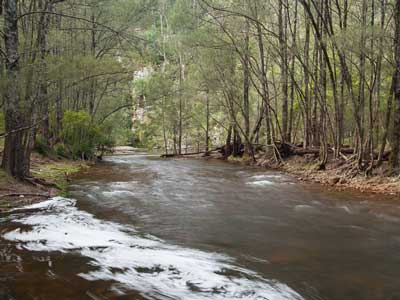 Eastern Riverine Forest,
Eastern Riverine Forest,
Kowmung River, Kanangra-Boyd National Park,
with a young stand of River Oak (Casuarina cunninghamiana) (Ian Brown)
The typical habitat of these forests is the sandy, cobble-stone river margins, which are subject to periodic flooding.
In the Greater Blue Mountains, these forests occur most prominently in the western parts of the region, along the Cox, Kowmung, Wolgan and Capertee rivers.
Threatened Ecological Communities of forested wetlands
River-flat Eucalypt Forest on Coastal Flood Plains (endangered) is likely to occur at low elevation along the major rivers in the eastern part of Blue Mountains National Park.
Forested Wetlands Flora
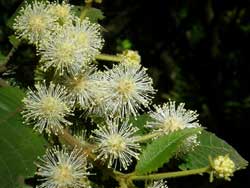 Black Wattle (Callicoma serratifolia)
Black Wattle (Callicoma serratifolia)
photo by: Alan Page
This image shows its dramatic new growth.
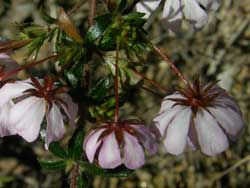 River Rose (Bauera rubioides )
River Rose (Bauera rubioides )
photo by: Alan Page
It's also known as the Dog Rose.
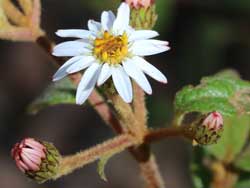 Oak-leaved Olearia (Olearia quercifolia)
Oak-leaved Olearia (Olearia quercifolia)
photo by: Alan Page
More Forested Wetlands Landscapes
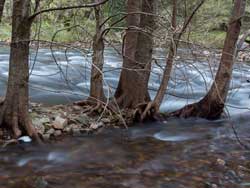 River Oaks in the Kowmung River,
River Oaks in the Kowmung River,
Kanangra-Boyd National Park
photo by: Ian Brown
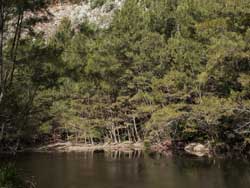 River Oaks line a gorge of the Kowmung River
River Oaks line a gorge of the Kowmung River
photo by: Ian Brown
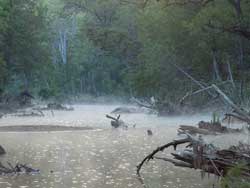 Forested Wetland of River Oaks,
Forested Wetland of River Oaks,
Capertee River, Wollemi National Park
photo by: Ian Brown
They line most of the large streams in the Blue Mountains, where they are one of the tallest tree species.

